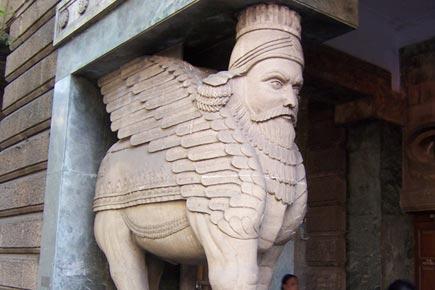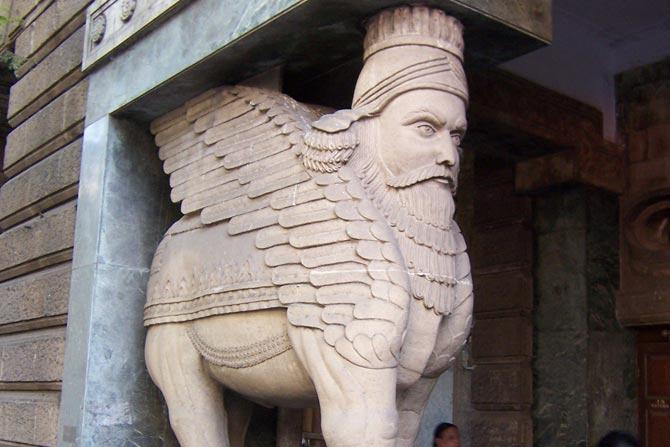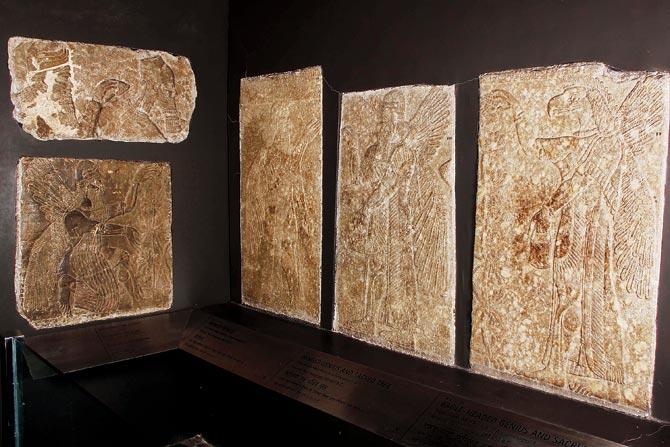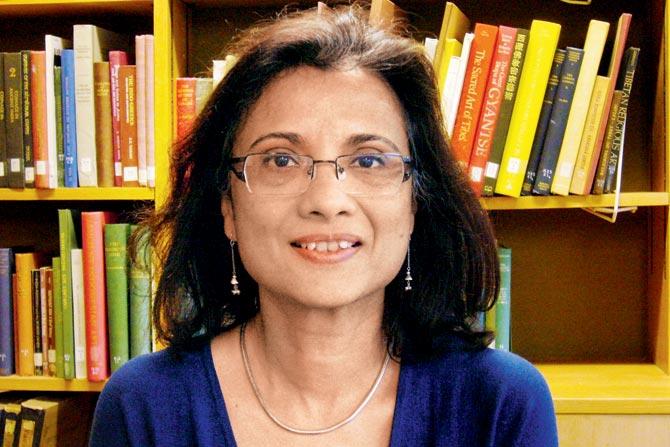City was the first in the world to host an exhibition of ancient Assyrian artefacts in the nineteenth century

Nineveh, the capital of the prosperous ancient empire of Assyria, has been in the news often this year, and for tragic reasons. In March, ISIS destroyed the ruins of Nineveh, the first in the long list of world heritage sites they have been tearing down in the cradle of civilization.
ADVERTISEMENT
In her new recently launched monograph, Artefacts of History: Archaeology, Historiography and Indian Pasts (published by Sage India), Dr Sudeshna Guha delves into better memories of Nineveh, and a little-known event in Mumbai’s past.

The Lamassu, a human-headed winged bull, was a protective deity in Assyria and is seen outside Vatcha Agiary at Fort. Pic/Wikimedia Commons
Dr Guha, associate researcher of Asian and Middle Eastern Studies at the University of Cambridge, writes about how the cultural wealth of the Assyrian empire, which spread across parts of modern Iraq, Iran, Egypt, Turkey and Cyprus, was first exhibited in 19th century Bombay, even before London or Paris. The chapter, titled Nineveh in Bombay: The Curation of Foreign Antiquities and Histories of India, reflects on the exhibition, and events surrounding it, which paint a picture of the social milieu of colonial India. She speaks to mid-day about the fall of Nineveh and of the time when Assyria was brought to Bombay.
How did Mumbai become an important centre in the discovery and spread of Assyrian cultural artefacts?
The city was a venue to the first ever exhibition of Assyrian reliefs, which were sent to London by the excavator of Nimrud, Austen Henry Layard. Layard’s consignments of bas-reliefs, obelisks and massive sculptural pieces were shipped from the port of Basra, in modern day Iraq, via Bombay to London between 1846 and 1848. The Asiatic Society of Bombay took the chance of displaying the antiquities. So, the citizens of Bombay in the 19th century were the first to see the splendour of Ancient Assyria. It was only later that the artefacts were displayed in London and Paris.

A display of the Assyrian collections at the Chhatrapati Shivaji Maharaj Vastu Sangrahalaya (CSMVS) from the original consignments between 1846-1848. Pic/CSMVS
What is the importance of Nineveh?
Nineveh (near Mosul, Iraq) is one of grandest and oldest cities of antiquity. It came to be from the period of the Assyrian Empire, and it became the capital city of this Empire under the rule of the mighty Sennacherib (704-681). It was also a well-planned city with public parks, irrigation ditches and aqueducts. It was a city of learning, which hosted innovations in the arts and sciences, and a fabulous and wealthy city, which facilitated commerce and trade between the East and West.
Can you elaborate on the importance of “the first exhibition of Ancient Assyria in Bombay” in 1846?
The exhibition was held at the Grant Road Buildings in 1846. In fact, the citizens of Bombay made a case for better civic amenities for their city when they were informed of the well-planned ancient city of Nineveh through the magnificent maps that were made in 1851. In Britain, by the mid-1850s, the Assyrian artefacts were derided as representations of ‘bad art’. In Bombay, the objects were viewed differently. For example, a journalist for The Bombay Times and Journal of Commerce described many ‘Indian features’ within the exhibits, like an armlet corresponding to ‘lower class male Hindoos’, swords resembling those of the ‘Maratha sirdars’ and Muslim rulers etc. The Assyrian collections, which were given by Henry Rawlinson to the Governor in 1848, were prominently displayed in the Economic Museum, which existed inside the Town Hall throughout the 1850s, and are now in the Chhatrapati Shivaji Maharaj Vastu Sanghralaya (CSMVS).

Dr Sudeshna Guha
Elements of Assyrian art, such as the human-headed winged bull, are central to the Parsis. Was the Parsi community in Mumbai welcoming of Assyria’s cultural wealth since it went back to their roots?
I do not have any evidence as yet to comment on this. However, we do have evidence to show that the nineteenth century Parsi antiquarians of Bombay (those who were members of the Asiatic Society) took a remarkable interest in the contemporary archaeological scholarship of West Asia, for their researches into the histories of the origins of their own community, and of the Zoarastrian religion.
Did Assyrian art and architecture influence Mumbai’s art architecture?
I did not have the opportunity to discuss this in my book. However, I have come across a photograph of Assyrian relief on a building in Fort, in a photograph of the city taken by photographer Sanjeet Chowdury.
Why were British historians such as James Fergusson interested in drawing comparisons between Indian and Assyrian cultures?
Fergusson saw Ancient Assyria as the historical corridor linking Asia with Europe, and linking Persia to India, and suggested that the Hindus, or the ‘aryans’ had come to India from this land. He used the archaeological excavations and Assyrian artefacts to build up a racial history for India, which had no evidential substance.
 Subscribe today by clicking the link and stay updated with the latest news!" Click here!
Subscribe today by clicking the link and stay updated with the latest news!" Click here!








